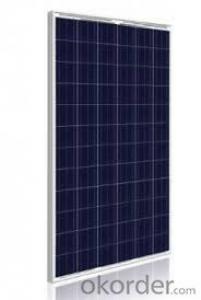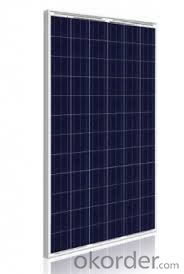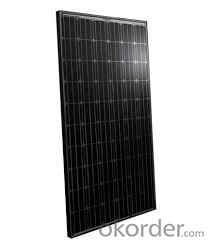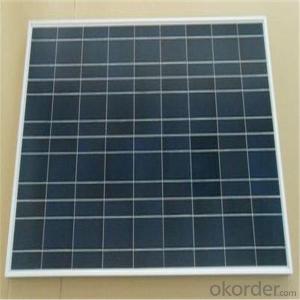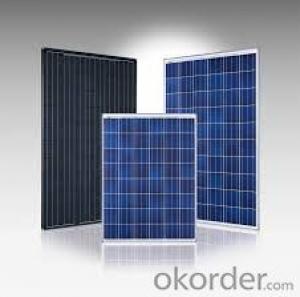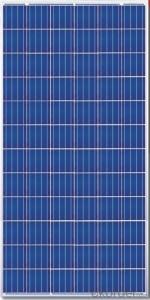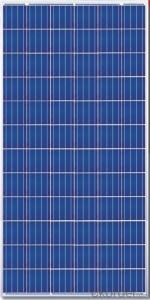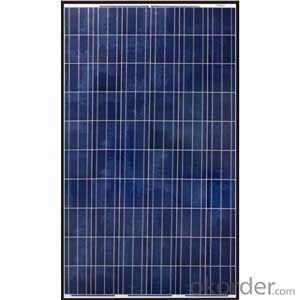235W Bendable Solar Cells Poly Solar Panel with Factory Direct Sale CNBM
- Loading Port:
- Qingdao
- Payment Terms:
- TT OR LC
- Min Order Qty:
- 10 set
- Supply Capability:
- 300000 set/month
OKorder Service Pledge
OKorder Financial Service
You Might Also Like
Polycrystalline Solar Modules
CNBM offers a range of small, medium and large polycrystalline solar modules, designed for a range of requirements.
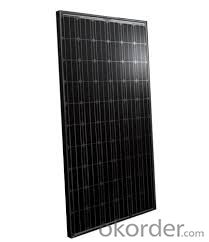
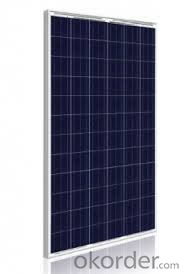
Specifications:
Tolerance | +/-3% |
Cell | Polycrystalline silicon solar cells (156 x 156mm) |
N0. of Cells | 60 (10 x 6) |
Dimension of Modules (mm) | 1650 x 990 x 40 |
Weight (kg) | 25.5 |
Limits:
Operating Temperature | -40~+85? |
Storage Temperature | -40~+85? |
Maximum System Voltage | 1000 VDC max. |
Hail Impact | Diameter of 28mm with impact speed |
Temperature and Coefficients:
NOCT | 48C+/-2? |
Voltage temperature coefficient (%/K) | -0.35 |
Current temperature coefficient (%/K) | 0.05 |
Power temperature coefficient (%/K) | -0.45 |
Characteristics:
Model: | SGM-200P | SGM-210P | SGM-220P |
Max-power voltage Vmp (V) | 29.2 | 29.4 | 29.41 |
Max-power current Imp (A) | 6.85 | 7.14 | 7.48 |
Open-circuit voltage Voc (V) | 36.5 | 36.69 | 36.9 |
Short-Circuit Current Isc (A) | 7.28 | 7.6 | 7.93 |
Max-power Pm(W) | 200 | 210 | 220 |
Model: | SGM-230P |
Max-power voltage Vmp (V) | 29.8 |
Max-power current Imp (A) | 7.72 |
Open-circuit voltage Voc (V) | 37.31 |
Short-Circuit Current Isc (A) | 8.19 |
Max-power Pm(W) | 230 |
STC: Irradiance 1000W/m2, module temperature 25?, AM-=1.5
Poly Crystalline Solar Panels Specifications Range
Maximum Power (Pm) | Dimension | Weight | Operating Voltage (Vmp) | Operating Current (Imp) | Open Circuit Voltage (Voc) | Short Circuit Current (Isc) |
0.45W | 140x80x10mm | 0.08kg | 3.3V | 150mA | 4.6V | 160mA |
1.0W | 162x140x10mm | 0.16kg | 7.5V | 150mA | 10.3V | 160mA |
4.5W | 269x251x23mm | 0.8kg | 16.5V | 0.27A | 20.5V | 0.3A |
10W | 420.1×268.9×22.6mm | 1.92kg | 17.5V | 0.58A | 20.5V | 0.6A |
20W | 425x502x50mm | 3.0kg | 16.8V | 1.19A | 21.0V | 1.29A |
30W | 593x502x22.6mm | 3.9kg | 16.8V | 1.78A | 21.0V | 1.94A |
40W | 655x537x50mm | 5.75kg | 17.3V | 2.31A | 22.1V | 2.54A |
50W | 839x537x50mm | 6.0kg | 17.5V | 2.9A | 21.8V | 3.17A |
65W | 1111x502x50mm | 7.2kg | 17.6V | 3.69A | 22.1V | 3.99A |
80W | 1204x537x50mm | 7.7kg | 17.6V | 4.55A | 22.1V | 4.8A |
- Q: Can solar cells be used for powering electric water heaters?
- Yes, solar cells can be used to power electric water heaters. By harnessing sunlight and converting it into electricity, solar cells can provide a sustainable and renewable energy source to heat water in electric heaters. This helps reduce reliance on traditional power grids and contributes to a greener and more eco-friendly way of heating water.
- Q: How do solar cells convert sunlight into electricity?
- Solar cells convert sunlight into electricity through the photovoltaic effect. When sunlight hits the solar cell, it excites the electrons in the cell's semiconductor material, causing them to flow as an electric current. This flow of electrons is then captured and harnessed as usable electricity.
- Q: What information can I get from the Internet about the solar cell modules? Such as what it is? How it is made?
- Here is what I can found online about the solar cell module for your information: A bulk silicon PV module consists of multiple individual solar cells connected, nearly always in series, to increase the power and voltage above that from a single solar cell. The voltage of a PV module is usually chosen to be compatible with a 12V battery. An individual silicon solar cell has a voltage of just under 0.6V under 25 °C and AM1.5 illumination.
- Q: Can solar cells be used to power farms or agricultural operations?
- Yes, solar cells can be used to power farms or agricultural operations. Solar panels can be installed on rooftops, fields, or other suitable areas to convert sunlight into electricity. This renewable energy source can provide a consistent and sustainable power supply for various farming activities, such as irrigation systems, machinery, and storage facilities. Additionally, solar power helps reduce reliance on fossil fuels, lowers operational costs, and contributes to a greener and more environmentally friendly agricultural sector.
- Q: What is the best way to deal with surplus solar cells abandoned after burning?
- Unfortunately abandoned solar cells are not easy to recycle. Only the aluminium frame can be reused, and the surplus is sometimes inseparable; because the solar cell contains silicon, tin, nickel, silver metal.
- Q: What is the working principle of a solar cell?
- A solar cell is a solid-state electrical device (p-n junction) that converts the energy of light directly into electricity (DC) using the photovoltaic effect.
- Q: Can solar cells be used for powering communication towers?
- Yes, solar cells can be used for powering communication towers. Solar panels can convert sunlight into electricity, which can then be used to power various devices and systems, including communication towers. This renewable energy source provides a sustainable and cost-effective solution for powering communication infrastructure in remote areas or areas with limited access to the grid. Solar-powered communication towers have become increasingly popular as they are environmentally friendly and can reduce reliance on traditional energy sources.
- Q: Can solar cells be used for hydrogen production?
- Yes, solar cells can be used for hydrogen production through a process called electrolysis, where the electrical energy generated by the solar cells is used to split water into hydrogen and oxygen. This method, known as solar water splitting, offers a sustainable and renewable way to produce hydrogen without carbon emissions.
- Q: How do solar cells impact energy poverty?
- Solar cells can have a significant impact on energy poverty by providing access to clean and affordable electricity in areas with limited or no grid connectivity. They enable the generation of renewable energy, reducing reliance on fossil fuels and expensive and unreliable energy sources. Solar cells also empower communities to become self-sufficient, improving living standards, promoting economic development, and enhancing educational opportunities. By harnessing the power of the sun, solar cells play a crucial role in addressing energy poverty and promoting sustainable development.
- Q: Can solar cells be used on rooftops with different orientations?
- Yes, solar cells can be used on rooftops with different orientations. While the ideal orientation for maximum energy production is typically south-facing, solar panels can still generate electricity when facing east, west, or even north. However, the energy output may vary depending on the orientation, so it's important to consider factors like shading and angle adjustments to optimize their performance.
Send your message to us
235W Bendable Solar Cells Poly Solar Panel with Factory Direct Sale CNBM
- Loading Port:
- Qingdao
- Payment Terms:
- TT OR LC
- Min Order Qty:
- 10 set
- Supply Capability:
- 300000 set/month
OKorder Service Pledge
OKorder Financial Service
Similar products
Hot products
Hot Searches
Related keywords
